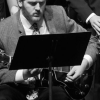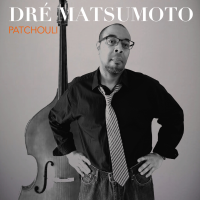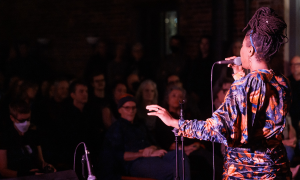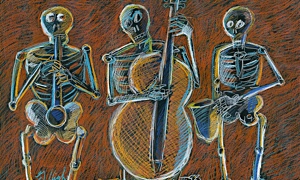Home » Jazz Articles » What is Jazz? » Deconstructing Money Jungle
Deconstructing Money Jungle

On September 17, 1962, Duke Ellington, Max Roach and Charles Mingus got together with no rehearsals for a recording session of trio music. All that the sidemen were given before playing were lead sheets with written melody and chords, and a visual description of the meaning of the piece. For the title track, Ellington told his sidemen to visualize that "crawling around on the streets are serpents who have their heads up; these are agents and people who have exploited artists. Play that along with the music." Charles Mingus had been a long time admirer of Ellington and although he may have been excited to have been asked to play with his longtime hero, he did not show any sign of it; stating that he would only play the date if they would hire Max Roach to play drums. This recording represents the coming together of the older tradition and the younger bop schooled musicians who had moved away from what many of them considered to be "Uncle Tom" music. Mingus and Roach played music for musicians; Ellington was an entertainer who played dance music. Ellington's music was being performed in dance halls and his larger more artistic compositions were reserved for concert halls while the beboppers were still in smoke filled clubs with no dance floors. This recording session was the summit of two generations that bridged the gap between swing and bop. It was the arrival of the avant-garde that would define the turmoil of the middle and late sixties. In this session Duke Ellington collaborated with Charles Mingus and Max Roach to create on of the most important jazz albums of not just the decade but also the entire century. By collaborating with younger pioneers of more modern music, Duke allowed himself to be pulled into new harmonic, rhythmic and melodic ideas while Mingus and Roach were able to gain the experience of playing with a master of their art. This recording session marked a new sound in music that helped to shape the developing avant-garde jazz movement.
The album Money Jungle was officially released in February of 1963, just three months after the assassination of President John F. Kennedy marked the plunge into the chaos that was the middle and late sixties. Bringing together Duke Ellington, Charles Mingus, and Max Roach was not just recording three excellent and genius musicians; it also brought together three of the most radical civil rights activists in jazz. From the 1940's to the beginning of the 60's each one of these musicians released a work directly related to issues of civil rights. Max Roach's We Insist! (Max Roach's Freedom Now Suite) was first released in 1960, following Mingus' Mingus Ah Um which features the piece "Fables of Faubus," a direct reaction to Arkansas Governor Orval E. Faubus calling in the national guard to prevent nine African American children from entering an all white school. Mingus originally wrote lyrics to this piece that Columbia Records refused to record, as they were too controversial, and it would be another year before Charles Mingus would record a version with his original lyrics. Inspiring all of this was Ellington's Black, Brown, and Beige, an extended composition that tracked the roots of the African American from the days of slavery to the very beginning of the civil rights movement that his consciousness-raising work would help to ignite.
Ellington, Mingus and Roach all had very different interpretations of the 20th century struggle that black men and women had to deal with. Ellington was more reflective with a historical approach, but Mingus and Roach were aggressive. Roach's title We Insist! says it all. These are individuals who have become aggressive through years of oppression, and are ready for the leadership of figures like Malcolm X and Dr. Martin Luther King Jr. This aggression comes through in Mingus' bass playing and string bending on Money Jungle and Backward Country Boy Blues, and in Max Roach's intense, driving bop and hard bop technique that he pioneered. These musicians were doing more than just playing on this day in 1962; they were expressing their dissatisfaction with a society that did not value their very existence. This recording takes the listener on an existential journey for meaning through the medium of the avant-garde.
Ellington was one of the most pioneering American composers in the 20th century in regards to harmonic structure, rhythm, and arranging. He created the paradigm of American music that Mingus and Roach were working to shift. Despite all of Duke Ellington's amazing innovations in compositions and in music, it is important to note that until this point his music was primarily dance music. Jazz had strayed far from "Jungle Nights in Harlem" and was now reserved for smaller clubs that hosted quintets with no room for dance. Hipsters, beats, and poets who were into liberal experimentation with sex, drug use and improvisatory art, were replacing well-dressed upper class patrons looking for an evening of big band swing. This new direction drags Ellington into new treatments of dissonance and motivic ideas. The title track Money Jungle in its most basic form is just a 12 bar blues. Mingus' aggressive bass style grouped with Ellington stretching into more altered and unresolved chord tensions and Max Roach's fiery drumming, creates a completely different approach to playing a blues. Where most jazz basses would walk, Mingus moves to the upper end of his range digging into one note so aggressively on one motivic theme that he bends the pitch. He rarely plays a straight walking bass line for even an entire chorus. This alteration in style for Ellington led to players altering forms entirely and even throwing them away to create more avant-garde music.
Charles Mingus and Max Roach came from the Charlie Parker school of thought in terms of improvisation, and the Thelonious Monk school in regards to space, treatment of dissonance and from both they take logic. The beboppers were very logical yet very chaotic musicians. Their music involved playing long runs of swung eighth notes that sounded like Jackson Pollock splashing you with a paint can, yet each line was focused. Every downbeat was a chord tone, and all scale tones or chromatic tones happened on the offbeat. No matter how chaotic this music got it always had focus. Every musical phrase or idea was going somewhere, and it was never just floating off into the ether. They had more enlightened views on syncopation and harmony (particularly suspended dissonance). Just as Ellington's earlier records influenced them, these two musicians took Ellington down a road of more modern possibilities. While Ellington wrote the majority of the music for this album, Mingus and Roach bring an unperceived dimension to the music; such as Mingus insistently hitting the same high notes continuously even if they may not be rhythmically or harmonically functional in a traditional bass function. Rather than playing the role of a bassist for a piano trio, Mingus insists on being on the forefront and playing more compositional lines. When Ellington hears this he at first just fills in the blanks for Mingus' odd playing. By the time they get to Money Jungle, rather than playing more traditionally, Ellington is right behind Mingus; diving deeper into the abyss while Roach keeps everything together with his polyrhythmic style.
The intensity grew thick as the session went on. Mingus and Ellington had had falling-outs in the past but if they have any residual issues with one another neither of them had shown it. The real conflict was between Mingus and his contemporary: Max Roach. Among jazz musicians, and especially beboppers, there has always been a tendency to try and out do one another. Mingus had criticized some of Roach's playing that day and the producer of the album Alan Douglas recalls the boiling point of the session.
Mingus started to complain about what Max was playing. Mingus was getting louder and louder as the session went on. I forget what song they were doing, but in the middle of it Max kind of looked up at Mingus and smiled and said something. And at that point, Mingus picked the bass up, put the cover on it and just stomped out of the studio.
Ellington had to chase Mingus to the elevator and convince him to return by reminding him how good this record label had been to him. The tension between these three players be it due to Mingus' anger or the age gap between Duke and his sidemen, led to an interesting communication of music that often can sound more like a shouting match than one of Haydn's "intellectual conversations amongst equals."
It became clear that Duke was more than aware of the music his sidemen and their peers have been playing at the beginning the album with the opening track "Very Special." He had a Thelonious Monk style approach, rhythmically involving short motivic phrases displaced throughout the measure rather than more traditional melody based phrases, or the barrage of notes that Charlie Parker used to define a new generation of playing. Instead, Duke followed a method of phrasing that is similar to a style later explained by jazz educator and trombonist Hal Crook. Crook's method of improvisation follows several different steps with the idea of creating a motivic themed solo rather than an explosive bop solo, including utilizing space, repetition, fragmentation, extension, and displacement. Space meaning resting for entire measures or longer and repetition being rather self-explanatory, once a theme is developed the concept of fragmentation and extension simply means playing short parts of the theme rather than the whole phrase or extending it with more notes to take up more space. This is similar to Haydn's string quartet op.33 in Eb Major. The final method that Crook describes that all three musicians used, is the rhythmic displacement of the phrase. Ellington would take one phrase and play it starting it in different parts of the bar. This created rhythmic motion and can even fool listeners into thinking that more polyrhythmic ideas are being formed.
One of the main stylistic features of this album is Mingus' Delta-blues influenced playing. He was able to mimic the sound of a Robert Johnson or Son House style slide guitar on his bass. His sound on this album has also often been compared to the Brazilian berimbau. Though he was known as one of the most virtuosic double bassists of all time, Mingus chose to put feeling and instinct before virtuosity on this album. Mingus was making a statement about his heritage here. He was playing in a way that was directly influenced by African American music. He plays as if he was struggling, as if he had the weight of an entire movement resting on his shoulders. His compatriots joined him in this endeavor and helped to ease his load as they followed suit in his motivic ideas.
This album is usually not considered to be "avant-garde" by critics and jazz literary figures, but it does embody the movement that the avant-garde spear headed. Around the recording of this album and its release, Ornette Coleman had brought his quartet to New York City and John Coltrane was putting together what is arguably the most famous avant-garde jazz ensemble of all time. All these musicians were living and working in the same city and were very much aware of one another. Within 10 days of recording Money Jungle, Duke Ellington also made a record of music with John Coltrane in a much more traditional style. Seeing as this recording followed the Money Jungle, session it is very likely that Ellington told Coltrane about the session and maybe even showed him some of the music. The treatment of dissonance on this album, and adjustments made to traditional 12-bar blues forms directly correlates with and reflects the turmoil of the avant-garde sound and the violence of the late 50's and 60's. Jazz of this era became more about listening to one another, rather than playing simply when it was your turn. These musicians improvised as a unit, not as individuals.
By the middle sixties, arrived the avant-garde had taken over jazz. Ornette Coleman had brought his free jazz quartet from the west coast to New York. John Coltrane had released A Love Surpeme (1965), and the Mingus Jazz Workshop was in full swing. Coleman brought his west coast quartet to The Five Spot in New York City to showcase their new sound to an audience of mixed reactions. His ensemble was instructed to play what they heard rather than what was on the page. When the main melody ended and Coleman started to improvise, bassist Charlie Haden would outline the changes he heard in his head. Mingus, Coltrane, and even Leonard Bernstein went out to see this new phenomenon. Coltrane would even go up and sit in with the band. It is no coincidence that Ornette Coleman's album Free Jazz: A Collective Improvisation (1960) would feature a Jackson Pollock painting on the cover. Coltrane took his experiences with Coleman and Ellington and paired them with his own ideas about where music should be going, and the end result was A Love Surpeme, a four-part dedication focused around one chord. The music was chaotic but driven, and held together by the famous Coltrane quartet. Mingus' Jazz Workshop Concerts also focused on group improvisation in a similar way to Money Jungle. He had stretched his ensembles to larger groups rather than just a piano trio. His focus was more on group improvisation while still demonstrating his mastery of his old mentor Charlie Parker's style. They were bebopping still, but all together now. All of this music came out of the unrest of the civil rights movement and the constant violence that filled with streets of New York and the whole country. Not only were black men and women being beaten down in the streets, but also protests were breaking out everywhere to try an end a violent war being fought in Vietnam. The cold war was reaching its peak and the entire world seemed to be in unrest and the music reflected the frustrations of an entire generation.
In 2013 Terry Lyne Carrington, Christian McBride and Gerald Clayton got together to record a tribute to this historic album, finally cementing it as one of the most important albums in jazz. They reimagined Ellington's compositions and took their own liberties and emotions with the music, while still maintaining the stylistic ideals of the old masters. When the original album was first released, Down Beat magazine's Don DeMicheal described how Roach and Mingus push Ellington and then how Ellington took charge. "I've never heard Ellington play as he does on this album; Mingus and Roach, especially Mingus, push him so strongly that one can almost hear Ellington show them who's boss—and he dominates both of them, which is no mean accomplishment."
This is an album that embodies the romantic fragment. It leaves the listener wanting more, filled with unresolved dissonance as Mingus plays almost Webernian style phrases. Ellington has a long history as a composer and musician yet he always said that Newport in 1956 was where he was born; but it is Money Jungle where he steps into a new suit and abandons his comfort zone completely. This was music for searching. It took intense commentaries on the racial and economic issues of the time and still reminds musicians that conventional ideas of harmony, rhythm and form are entirely open to interpretation.
Bibliography
Carrington, Terry Lyne, Money Jungle: A Provocation in Blue, Recorded on Blue Note, 2013, Compact Disc.Ellington, Duke, The Carnegie Hall Concerts: January 1943, Prestige, 1977 33 1/3 rpm
Ellington, Duke, Money Jungle, United Artists, 1962, New York City, New York
Mattingly, Rick, The Drummer's Time: Conversations with the Great Drummers of Jazz (Fairfield NJ: Hal Leonard, 1998), 60.
Milkowski, Bill, "Money Jungle 50 Years After the Summit" Downbeat (2013).
Mingus, Charles. Beneath the Underdog; His World as Composed by Mingus. New York: Knopf, 1971.
Mingus, Charles, Charles Mingus Presents Charles Mingus, Recorded on Candid Records, 1960, New York City, New York, 33 1/3 rpm.
Peress, Maurice. Dvořák to Duke Ellington: A Conductor Explores America's Music and Its African American Roots. Oxford: Oxford University Press, 2004.
Roach, Max, We Insist! Recorded on Candid Records, 1960, New York City, New York, 33 1/3 rpm.
Tags
duke ellington
What is Jazz?
Graham E Peterson
Max Roach
Charles Mingus
Charlie Parker
Thelonious Monk
Ornette Coleman
New York City
John Coltrane
Charlie Haden
Terry Lyne Carrington
Christian McBride
Gerald Clayton
PREVIOUS / NEXT
Support All About Jazz
 All About Jazz has been a pillar of jazz since 1995, championing it as an art form and, more importantly, supporting the musicians who make it. Our enduring commitment has made "AAJ" one of the most culturally important websites of its kind, read by hundreds of thousands of fans, musicians and industry figures every month.
All About Jazz has been a pillar of jazz since 1995, championing it as an art form and, more importantly, supporting the musicians who make it. Our enduring commitment has made "AAJ" one of the most culturally important websites of its kind, read by hundreds of thousands of fans, musicians and industry figures every month.


























